Pergamon
Author: Stefan Dorra & Ralf zur Linde
Publisher: Eggertspiele / Amigo
Year: 2011
review by

| x |
|
|
|
|
|
|
|
|
|
|
|
|
|
|
|
|
|
|
|
|
|
|
|
|
|
|
|
|
|
|
|
|
|
|
|
|
|
|
|
|
|
|
|
|
|
|
|
|
|
|
|
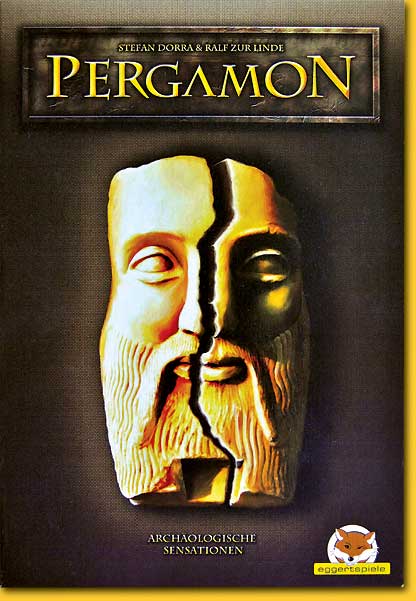 |
What does one do when a country is weakened, has social unrest and is known as ‘the sick man of Europe’ everywhere else in the civilized world? There are many options, and looting is one of them. The fact that it happened widespread, organized and under the guise of culture, doesn’t make it less reprehensible. In the nineteenth century however this was common practise, feelings of national or racial superiority prevailed, and together with a genuine interest in antiquity expeditions were sent out everywhere that eventually came home with the most valuable treasures that subsequently were exhibited.
Of course, before the expedition starts the necessary funds will have to be collected, and the rumour of fabulous treasures also activates competing parties.
The player that succeeds in attracting the most visitors to his exhibitions at the end of the twelve rounds of the game has won. |
|
|
|
|
|
|
| x |
|
|
|
|
|
|
|
|
|
|
|
|
|
|
|
|
|
|
|
|
|
|
|
|
|
|
|
|
|
|
|
|
|
|
|
|
|
|
|
|
|
|
|
|
|
|
|
|
|
|
|
| Each round starts with placing five artefacts on the excavation site. The artefacts can be found near the surface or several levels deeper, depending on their antiquity, and the placing of the artefacts over the excavation site is according to this age. |
|
|
|
|
|
|
|
|
| x |
|
|
|
|
|
|
|
|
|
|
|
|
|
|
|
|
|
|
|
|
|
|
|
|
|
|
|
|
|
|
|
|
|
|
|
|
|
|
|
|
|
|
|
|
|
|
|
|
|
|
|
 |
|
|
|
|
|
|
| x |
|
|
|
|
|
|
|
|
|
|
|
|
|
|
|
|
|
|
|
|
|
|
|
|
|
|
|
|
|
|
|
|
|
|
|
|
|
|
|
|
|
|
|
|
|
|
|
|
|
|
|
| After this the size of the research funds the anonymous donors provide is determined. This is done through two cards from a blind stack that on their back show the range of the funds; the grey, dimmed coins show the possible funds, and the yellow coins show the sure payment. What the real payment is, shown on the front of the cards, ranging from a possible low to a fortunate high payment, is only revealed later. The research funds is the total for all players and will have to be divided in some way among them. |
|
|
|
|
|
|
|
|
|
|
| x |
|
|
|
|
|
|
|
|
|
|
|
|
|
|
|
|
|
|
|
|
|
|
|
|
|
|
|
|
|
|
|
|
|
|
|
|
|
|
|
|
|
|
|
|
|
|
|
|
|
|
|
 |
| x |
|
|
|
|
|
|
|
|
|
|
|
|
|
|
|
|
|
|
|
|
|
|
|
|
|
|
|
|
|
|
|
|
|
|
|
|
|
|
|
|
|
|
|
|
|
|
|
|
|
|
|
This is done as each player, in player order, places his token on a preferred position on a socalled research fund row that indicates the desireable fund and at the same time shows the maximum depth at which that player may excavate. After all players have placed their token the two fund cards are turned face up that now reveal the actual funds. The research fund row now gets worked from right to left and each player may take the money from his position on the row, but only if there is enough money left when it is his turn!
A player may use his money to excavate and take all the artefacts from a specific level, or he may keep the money and use it in a following round. |
|
|
|
|
|
|
| x |
|
|
|
|
|
|
|
|
|
|
|
|
|
|
|
|
|
|
|
|
|
|
|
|
|
|
|
|
|
|
|
|
|
|
|
|
|
|
|
|
|
|
|
|
|
|
|
|
|
|
|
 |
|
But there is only so much money available as there is money shown on the cards. This means a player may not want to place his token left of any other player as the risk of getting no money at all is too great to him. But for the really gambling player there is an incentive to place his token left of any other player, being the last to collect any if all funds. But if the funds were generous, and all other players were satisfied with a small fund, he not only takes what he desired, but all of the rest of the funds. |
|
|
|
| x |
|
|
|
|
|
|
|
|
|
|
|
|
|
|
|
|
|
|
|
|
|
|
|
|
|
|
|
|
|
|
|
|
|
|
|
|
|
|
|
|
|
|
|
|
|
|
|
|
|
|
|
| But most things can not stand against laying in the ground; it is already difficult enough to get a cup or glass integral out of the dishes under domestical circumstances, so it is no wonder that the artefacts are excavated as fractures, each artefact in two different halves. In order to exhibit them they will have to be reunited with a fitting other half, so gradually players have their artefacts in front of them like Scrabble letters. However, only three artefacts may be taken into the next round without having to pay for it, and because money is rather scarce this does not happen too often. |
|
|
|
| x |
|
|
|
|
|
|
|
|
|
|
|
|
|
|
|
|
|
|
|
|
|
|
|
|
|
|
|
|
|
|
|
|
|
|
|
|
|
|
|
|
|
|
|
|
|
|
|
|
|
|
|
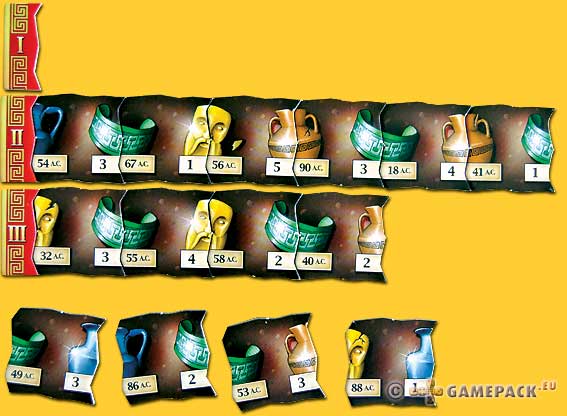 |
|
|
| x |
|
|
|
|
|
|
|
|
|
|
|
|
|
|
|
|
|
|
|
|
|
|
|
|
|
|
|
|
|
|
|
|
|
|
|
|
|
|
|
|
|
|
|
|
|
|
|
|
|
|
|
When a player has managed to knit a series of artefacts together and decides to exhibit them, he adds the points of each complete artefact and places a marker in the museum on this total. For his effort he already gets a one visitor chit, corresponding one point.
A player can hold up to three exhibitions at a time. Each time when a player opens a new exhibition, all markers of exhibitions that have a smaller collection and lesser points, are decreased by on position –also that players own exhibitions! |
|
|
|
|
|
|
|
|
|
|
| x |
|
|
|
|
|
|
|
|
|
|
|
|
|
|
|
|
|
|
|
|
|
|
|
|
|
|
|
|
|
|
|
|
|
|
|
|
|
|
|
|
|
|
|
|
|
|
|
|
|
|
|
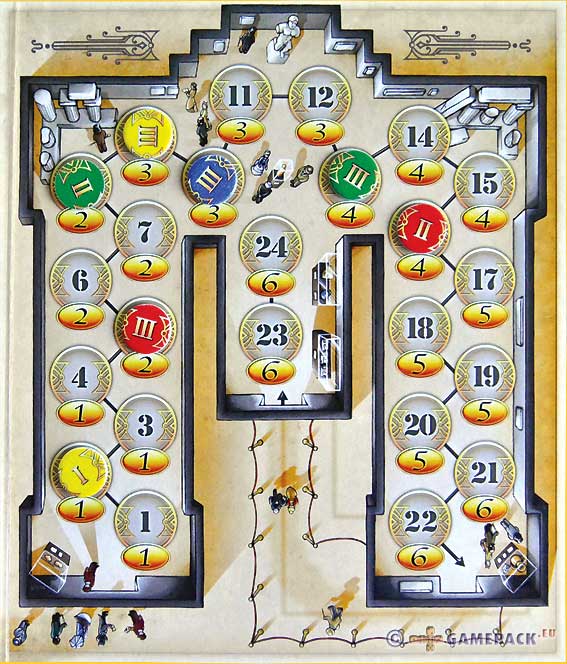 |
|
|
| x |
|
|
|
|
|
|
|
|
|
|
|
|
|
|
|
|
|
|
|
|
|
|
|
|
|
|
|
|
|
|
|
|
|
|
|
|
|
|
|
|
|
|
|
|
|
|
|
|
|
|
|
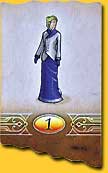 |
|
Four times in the game the museum gets scored. Each player gets as many visitors/points as his marker indicates. At the same time certain artefacts are scored; the player with the oldest artefact of a given kind earns two additional points. After this score, all exhibitions in the museum get a devaluation by moving the markers according to the stated number for that round. After the twelfth round there is a special bonus for the three players that have the eldest three artefacts evah in their exhibition, but this bonus can be rewarded to the same player if he owns these all! After this the visitors/points get counted and the winner determined. |
|
|
|
|
|
|
|
|
|
|
|
| x |
|
|
|
|
|
|
|
|
|
|
|
|
|
|
|
|
|
|
|
|
|
|
|
|
|
|
|
|
|
|
|
|
|
|
|
|
|
|
|
|
|
|
|
|
|
|
|
|
|
|
|
| x |
|
|
|
|
|
|
|
|
|
|
|
|
|
|
|
|
|
|
|
|
|
|
|
|
|
|
|
|
|
|
|
|
|
|
|
|
|
|
|
|
|
|
|
|
|
|
|
|
|
|
|
| x |
|
|
|
|
|
|
|
|
|
|
|
|
|
|
|
|
|
|
|
|
|
|
|
|
|
|
|
|
|
|
|
|
|
|
|
|
|
|
|
|
|
|
|
|
|
|
|
|
|
|
|
 |
|
|
|
|
|
|
|
|
|
|
|
|
|
|
|
|
|
|
|
|
|
|
|
|
|
|
|
|
|
|
|
|
|
|
|
|
|
|
|
|
|
|
|
|
|
|
|
The nicest element of the game is the placing of the player token on the research funds row, the tension if there will be enough funds once the player may collect his share and if another player does not take the artefact he actually needed himself too to complete his exhibition.
An excavation row becomes more interesting once round after round more artefacts are added. It also is better not to go for artefacts each round but skip a round once in a while and keep the money for a better occasion, using it to go for the more valuable artefacts and at the same time be the first to excavate to form a valuable collection and consequently make an exhibition. |
|
|
| x |
|
|
|
|
|
|
|
|
|
|
|
|
|
|
|
|
|
|
|
|
|
|
|
|
|
|
|
|
|
|
|
|
|
|
|
|
|
|
|
|
|
|
|
|
|
|
|
|
|
|
|
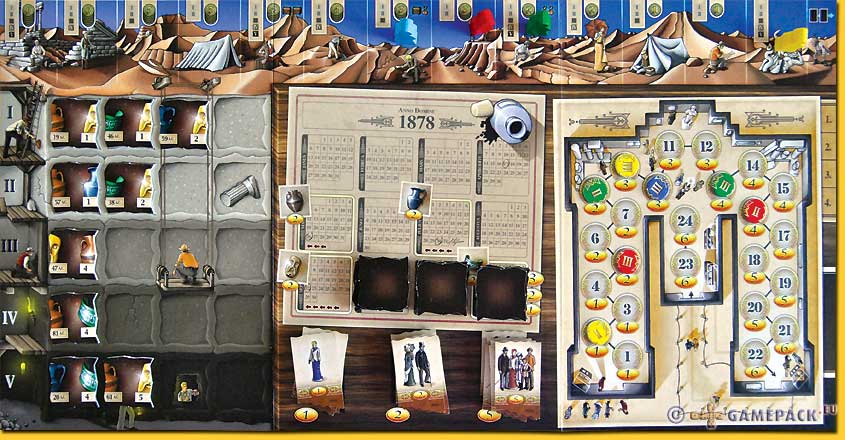 |
| x |
|
|
|
|
|
|
|
|
|
|
|
|
|
|
|
|
|
|
|
|
|
|
|
|
|
|
|
|
|
|
|
|
|
|
|
|
|
|
|
|
|
|
|
|
|
|
|
|
|
|
|
‘Pergamon’ is a collecting game that is pepped up with a minimum of elements. The execution of the game is on the dull side and brings about little ‘yes!’ feelings; this goes for both the illustrations as well as the graphic design. The research funds cards, the placing of the player token, the exhibitions; it is all quite transparent but also makes that the game feels a bit shallow and has little appeal, a quality a game should have in order to get replayed more than once in a while.
For families and players who do not want to play al too ‘deep’ ‘Pergamon’ is a nice choice; all others are advised to resort elsewhere, be it all inclusive or otherwise…
© 2011 Richard van Vugt
Pergamon, Stefan Dorra & Ralf zur Linde, Eggertspiele / Amigo, 2011 – 2 to 4 players, 10 years and up, 45 minutes
|
|
|
  |
|
|
|
|
|
|
|
|
|
|
|
|
|
|
|
|
|
|
|
|
|
|
|
|
|
|
|
|
|
|
|
|
|
|
|
|
|
|
|
|
|
|
|
|
|
|
|
  |
|
|
|
|
|
|
|
|
|
|
|
|
|
|
|
|
|
|
|
|
|
|
|
|
|
|
|
|
|
|
|
|
|
|
|
|
|
|
|
|
|
|
|
|
|
|
|
  |
|
|
|
|
|
|
|
|
|
|
|
|
|
|
|
|
|
|
|
|
|
|
|
|
|
|
|
|
|
|
|
|
|
|
|
|
|
|
|
|
|
|
|
|
|
|
|
| x |
|
|
|
|
|
|
|
|
|
|
|
|
|
|
|
|
|
|
|
|
|
|
|
|
|
|
|
|
|
|
|
|
|
|
|
|
|
|
|
|
|
|
|
|
|
|
|
|
|
|
|
| x |
|
|
|
|
|
|
|
|
|
|
|
|
|
|
|
|
|
|
|
|
|
|
|
|
|
|
|
|
|
|
|
|
|
|
|
|
|
|
|
|
|
|
|
|
|
|
|
|
|
|
|
 |
|
|
|
|
|
|
|
|
|
|
|
|
|
|
|
|
|
|
|
|
|
|
|
|
|
|
|
|
|
|
|
|
|
|
|
|
|
|
|
|
|
|
|
|
|
|
|
 |
|
|
|
|
|
|
|
|
|
|
|
|
|
|
|
|
|
|
|
|
|
|
|
|
|
|
|
|
|
|
|
|
|
|
|
|
|
|
|
|
|
|
|
|
|
|
|
| x |
|
|
|
|
|
|
|
|
|
|
|
|
|
|
|
|
|
|
|
|
|
|
|
|
|
|
|
|
|
|
|
|
|
|
|
|
|
|
|
|
|
|
|
|
|
|
|
|
|
|
|
 |
|
|
|
|
|
|
|
|
|
|
|
|
|
|
|
|
|
|
|
|
|
|
|
|
|
|
|
|
|
|
|
|
|
|
|
|
|
|
|
 |
|
|
|
|
|
|
|
|
|
|
|
|
|
|
|
|
|
|
|
|
|
|
|
|
|
|
|
|
|
|
|
|
|
|
|
|
|
|
|
|
|